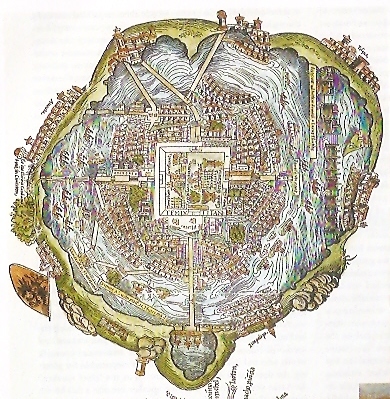| Spanish Empire- The Aztec Campaign 1.1 |
|
Figure 1-1 At its height, the Aztec capital Tenochtitlan
was as populous as Europe's largest city. As can be seen from this map,
it spread in concentric circles, with the main religious and political
buildings in the center, and residences radiating outward. (Tigno. 96) |
| The Aztecs were the most advanced society in Mexico during the
16th century. As the empire of Mesoamerica,
the Aztecs were increasingly expanding into the surrounding regions to defeat
other tribes. Conquest was an essential part of society as rival tribes were
brought under submission by force. Economic development through annual
tribute of subjugated tribes was essential to carrying out the task of
expanding Aztec rule. Captured prisoners of war were either used as labor or
ritual sacrifices in order to please the gods of the land. |

Figure 1-2 As the city was built on immense
island, its outskirts connected a mosaic of floating gardens producing
food for urban markets. Canals constantly irrigated the land, waste was
used as fertilizer, and the tremendously high yields were easily
transported to markets. Observe how entire households worked: men,
women and children all had roles in Aztec agriculture. (Tignor. 96) |
| Aztec society was highly centralized and
operated in a very orderly fashion. Every individual had an occupation in which
they performed to their very best. Specialization of labor increased efficiency
and produced more goods and services for Aztec society as a whole. Some were
warriors, others were craftsmen, engineers, and farmers. Religion and duty
to land and emperor alike played an essential role in the life of the Indian. |
Next
Back |

